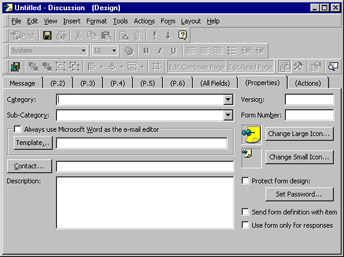Setting Form Properties
Before you publish your forms, you should set various form properties. These properties can be default or advanced.
Default Form Properties
Default form properties include the name of the form, the form description, and icons for the form. You set these properties on the Properties page, as shown in Figure 4-20.

Figure 4-20: The Properties page in an Outlook form
Following are the properties you can set on the Properties page:
-
Category Specifies a category name for your form, which will ultimately appear in the Choose Form dialog box. Use category names to group similar forms.
-
Sub-Category Specifies a subcategory for your form so you can divide your forms into subgroups. For example, a marketing forms category can be divided into advertising, events, pricing, and promotions.
-
Always Use Microsoft Word As The E-Mail Editor Specifies Word as the editor for the Message control of the form. By selecting this property, users can take advantage of the advanced features of Word.
-
Template Specifies which Word template to use for the Message control on your form.
-
Contact Specifies the contact responsible for the form. This name appears in the Choose Form dialog box if the user views the details about the form, and in the About dialog box for this form when the user chooses About This Form from the Help menu. (The About This Form command is not available if you send the form definition with the item.)
-
Description Allows you to enter the form description, which will appear in the Choose Form dialog box if the user views the details about the form, and in the About dialog box for this form.
-
Version Specifies a version number for the form. This version number will appear in the Choose Form dialog box and in the About dialog box for this form.
-
Form Number Specifies a number for the form, which will appear in the About dialog box for this form.
-
Change Large Icon Specifies the large icon that will be used when a user selects a large icon view for any folder containing this custom form.
-
Change Small Icon Specifies the small icon that will appear in the default, custom table, timeline, or icon view of the form.
-
Protect Form Design Specifies a password to protect the design of your form after you publish it. You should specify a password for all of your custom forms unless you want users to be able to modify or customize your form. For example, you should not password-protect business form templates, such as a joint marketing agreement form, that users will have to modify to meet their specific needs.
-
Send Form Definition With Item Allows you to save the form layout with the item. Use this feature if you are not going to publish the form in a forms library. When you save the form definition with the item, Outlook considers these forms to be one-off forms ”if you modify the form later and publish it to the forms library, any older items will continue to use the form definition saved inside of the item. This feature is useful for sending forms to users who are not in your organization or who do not have a copy of the Outlook form. For example, you can use this property to create an event registration form that users both inside and outside of your organization can use. This form will not be useful beyond the event, so you would not publish it into a forms library. Note that when you save the form definition with the item, Outlook displays a security warning if the form contains VBScript and is not published anywhere in the user's Outlook system. With Outlook 2002 and 2003, you do not get the warning dialog box. Instead, Outlook just doesn't run any script behind a form that has a form definition attached.
-
Use Form Only For Responses Makes your form available only as a response to other forms, so users cannot create your form directly from the Choose Form dialog box. Instead, they must open the parent form and use the methods provided in the parent to create the form. This option is useful if you want to create hidden forms for your application. (Outlook uses this feature to implement meeting responses.)
Advanced Form Properties
The advanced form properties help you create visually appealing forms. These properties allow you to specify the individual background colors or images for the pages of your forms and also the default mouse pointers. To set the advanced properties of your forms, in design mode, right-click on the desired page and choose Advanced Properties. (Be sure to click on the page, not on a control.) In the Advanced Properties window, select the options you want to modify. Figure 4-21 shows the Advanced Properties window.

Figure 4-21: The Advanced Properties window for a page on an Outlook form
EAN: 2147483647
Pages: 227